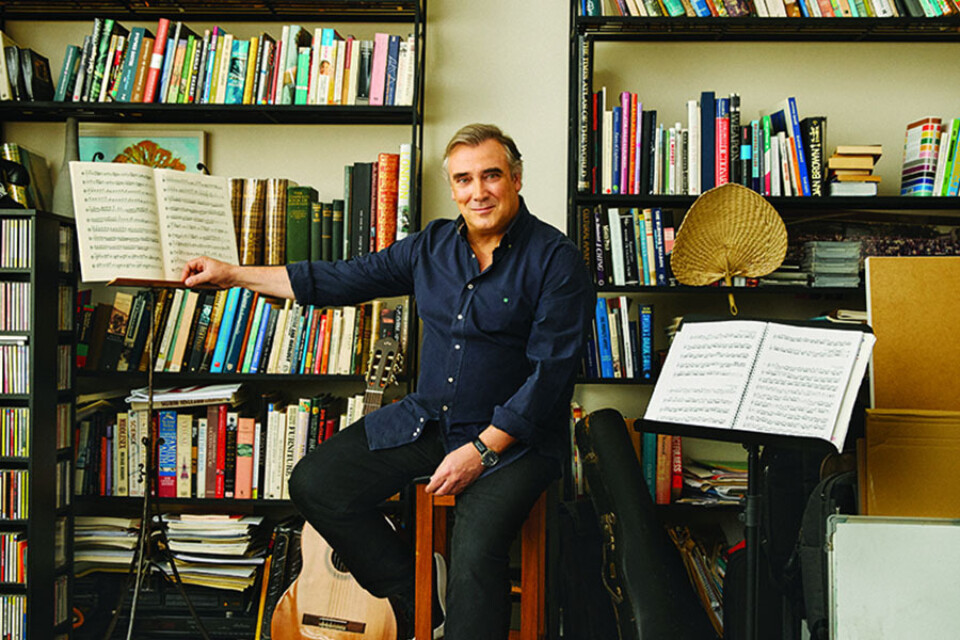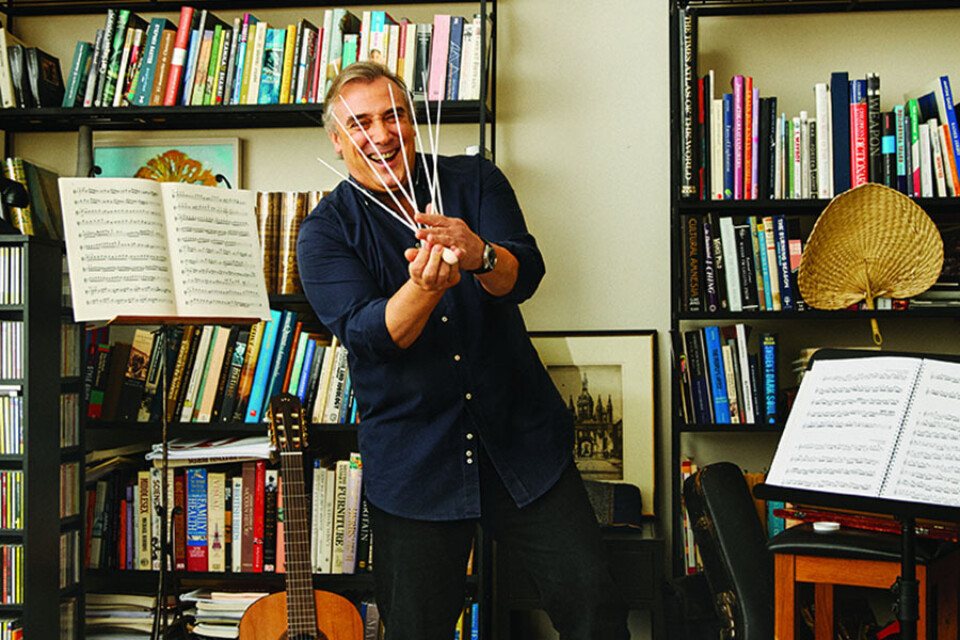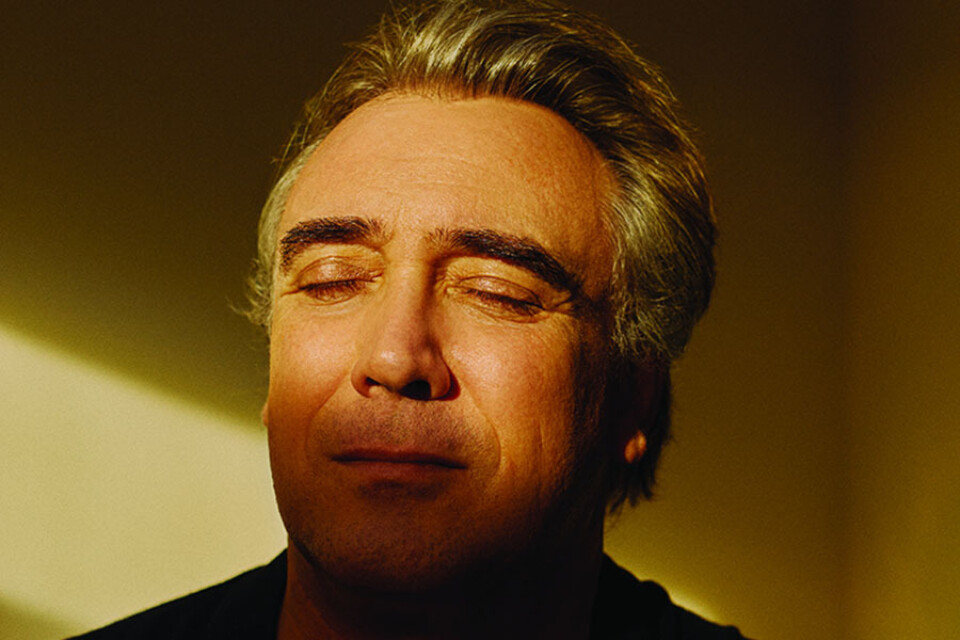This article appeared in the first edition of Encore: The Melbourne Symphony Orchestra magazine.
To have a printed copy of this biannual magazine delivered to your door, become a Friend of the MSO.
Brimming with enthusiasm, hugely talented, deeply passionate … meet Jaime Martín, the London-based Spanish conductor who takes the reins at the MSO.
____
Words: Stephanie Bunbury
Photography: Anna Huix
Hair and makeup: Mira Husseini

Jaime Martín feels he got the measure of Melbourne when he had to see a dentist during his last visit.
“I’m sitting there with my mouth open,” recalls Martín, “and he says, ‘What are you doing here?’ I’m a conductor. ‘Well, now you’re registered here, tell me when you do concerts and maybe we can meet afterwards; I can show you some bars!’”
Martín beams. “How nice that is! To be in a place where people detect that you are new in town or have some connection with the city and are so friendly and open – and proud! That’s what I find in Melbourne! ‘Look, this is us! This is how we live. Please join us!’”
Jaime (it’s pronounced Hi-meh) Martín takes up the position of Chief Conductor of the Melbourne Symphony Orchestra in February. It has been a whirlwind courtship; he first came to the MSO as a guest conductor two years ago. “From the first rehearsal it was love at first sight. At least on my side!”
He chuckles, a full-throated Spanish laugh. Stepping up to the podium on your first day with an orchestra is never easy, he says. “Everyone is silent and looking at you. ‘And now what? What are you going to tell us that we don’t already know?’ It is a delicate moment. But in some places, you feel deep down that everyone is willing to go, ‘OK, first of all, thank you for being here. What are we going to do?’ And I felt like that in Melbourne from the beginning.”
Musically, what struck him most was the orchestra’s flexibility. “I really appreciated that so much in that first program, because it was actually a difficult one.”
Ravel’s Mother Goose ballet score preceded Mozart’s Requiem. “They are completely different styles,” he says. “Ravel is full of colours and subtleties, lots of ethereal sounds. With Mozart, it is all much more structured, clear and articulated. I thought the orchestra was amazing in adjusting to the sounds. It is not, ‘This is how we sound, we are the MSO’. No, it’s incredibly open to explore – and that’s incredibly important.”
The plan now is that he will spend 15 weeks of the year in Melbourne in three five-week bursts, returning to his home base in London’s riverside suburb of Teddington or to his other post as Principal Conductor of the Los Angeles Chamber Orchestra. This is the life of a modern conductor, he says. He is just looking forward to spending five weeks in one place at a stretch, including some real weekends. “What I would like is to live in a residential area, somewhere you can meet your neighbours and go to the local shops.”


Jaime Martín is 56, but he has been working full-time as a conductor for only nine years. For most of his career, he has played the flute. Not that conducting was a new interest; when he was only 19, studying in The Hague in the Netherlands, there was the option of taking a course in conducting. But at the same time, he was chosen for the European Union Youth Orchestra – where he first met his wife Rachel Gough, who is now Principal Bassoon with the London Symphony Orchestra.
No way was he giving that up. “It was young musicians from all over Europe,” he recalls. “That was an incredible orchestra. And on my first project with this orchestra, the conductor was Claudio Abbado and the soloist was Jessye Norman; we were doing Schoenberg.
“The second tour was with Zubin Mehta; we went to India and met Ravi Shankar, playing the sitar. Imagine! I am 21; I love music and suddenly I have one-on-one time with Claudio Abbado and Zubin Mehta. I thought, ‘Well, if I was conducting, I would never meet these people.’ And if I want to get to know conducting, what better classroom than to play in the best orchestras I could?”
At the end of his studies, he moved to London and became Principal Flute at the Academy of St Martin in the Fields under the late Sir Neville Marriner, who often told him he should conduct.
When the transition came, he says with a grin, it was right at the time when men are supposed to have mid-life crises – in his early 40s. But this was anything but a crisis; it just crept up on him. He was asked if he would be interested in conducting a youth orchestra. “I thought, ‘Why not?’ I did it. And then, from that moment, it snowballed. People who listened to that concert invited me to do other things.” Nine years ago, he got his first position as Principal Conductor at Gävle in Sweden.
For Martín, it was always about the music. Flute was not his first choice. When he was eight, his father took him to his first orchestral concert in Santander, the city in northern Spain where he grew up. There were records at home, but they had never interested him. The experience of instruments playing live, however, was something else.
“That made me completely crazy. No, really!” He imagined playing the violin. Now when his father put Tchaikovsky on the turntable, he would grab a broomstick and pretend to saw away at its imaginary strings.
Martín was the eldest of six children living in a small apartment. There was no money for private lessons. It was possible, however, to learn a wind instrument for free through a scheme run by the city administration. Twice a week, he took lessons from the flute player in the Santander municipal band. “If I hadn’t had that possibility, I wouldn’t be here,” he says. “I loved the violin, but I am very thankful to the flute because, thanks to it, I made contact with music. And actually, as it happened, I was pretty good at it.”
“I loved the violin, but I am very thankful to the flute because, thanks to it, I made contact with music. And actually, as it happened, I was pretty good at it.”
At 15, he was travelling every week on an overnight train to Madrid – the local bank subsidised his ticket – to do a class at the Conservatorio. The train arrived at 8am and his class was at 4pm. “I didn’t have a place to stay, so I went to the centre of Madrid and did some busking. I would get some practice and the people would throw some coins.”
After the class he would be allowed to watch the Spanish Symphony’s weekly concert, then get back to the station. It seems a remarkable commitment for a boy of 15. Martín shrugs. “I had to miss out on some things, but actually I felt so lucky, you know, every time I was on that train.”
He remains a person of tremendous enthusiasms, by no means all musical ones. Talk turns to the family trekking expeditions to Machu Picchu, the Galápagos Islands and Borneo, where he and his younger son took recorders to play to their hosts in the jungle (the couple has two sons, aged 23 and 21); then it moves on to cooking and Martín’s favourite recipes for fish pie. Most exciting of all, however, are the programs in the pipeline.
On one of his visits to Melbourne he conducted a concerto by the composer Deborah Cheetham, who told him her story as one of the Stolen Generation. “I realised how important it is, what she represents. I was really moved,” he says.
In lockdown, he read more about Australia’s relationship with the past and its First Nations people before inviting Cheetham to write a new piece for his opening concert on the theme of morning, to be followed by Mahler’s First Symphony. “The soloist will be William Barton who is a very well-known Australian yidaki player and also a composer himself. Two First Nations artists, absolutely at the highest level, but they have never worked together before. It’s really very exciting!”
Serving a city of five million people, he says, the Orchestra must cater to broad tastes. But there are some enticing rabbit holes he wants to explore, including reviving local composers who have been largely forgotten.
“Margaret Sutherland: amazing! We are going to do a Spanish program in December, with flamenco music and dancing.
“And we are going to do Beethoven, Tchaikovsky and Mahler, but we are going to do a new piece by Brett Dean and the latest piece by Thomas Adès, The Exterminating Angel,” he enthuses. “For me, the important thing is to have as wide a combination of repertoire as possible.”
He is thrilled about all of it. And judging by the huge banner of his face on the Arts Centre spire when he was last in Melbourne – he sent a picture of it to his mother – Melbourne is ready to be thrilled by him. On the way back from the dentist, he says, his taxi driver asked what he did. He told him, to which the taxi driver said he was an MSO subscriber; could he have a selfie? “I thought this is ridiculous!” Martín gives another of those huge laughs. “I don’t know, maybe it was my lucky day, but I was very impressed by that. For me, this is the feel of the city.”
